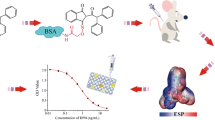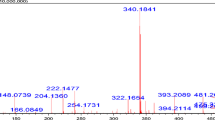Abstract
Five new rat monoclonal antibodies (mAbs) for 2,4,6-trinitrotoluene (TNT) and other nitroaromatic compounds, including, especially, the metabolite 2-amino-4,6-dinitrotoluene (2-ADNT), are described. Five heterogeneous, competitive enzyme-linked immunosorbent assays (ELISAs) were developed. Assay 1 uses mAb DNT4 3F6 as recognition element and gives a standard curve for TNT in 40 mmol L−1 phosphate buffered saline (PBS) with a test midpoint (IC50) of 0.26±0.08 μg L−1 (n=20). Assay 2 (mAb DNT4 4G4) has an IC50 of 0.35±0.07 μg L−1 (n=18), assay 3 (mAb DNT4 1A3) has an IC50 of 0.73±0.14 μg L−1 (n=15), and assay 4 (mAb DNT4 1A7) has an IC50 of 2.32±0.70 μg L−1 (n=15). Assay 5 (mAb DNT2 4B4) is very selective for 2-ADNT and has an IC50 of 8.5±1.7 μg L−1 (n=15) in PBS. These antibodies for nitroaromatic compounds differ not only in their sensitivity but also in their selectivity. Major cross-reactants are 1,3,5-trinitrobenzene, 2-ADNT, 4-amino-2,6-dinitrotoluene (4-ADNT), 2,4-dinitroaniline, 3,5-dinitroaniline, and 2,6-dinitroaniline. Although assay 5 is not highly sensitive, the mAb DNT2 4B4 in this assay is highly selective for 2-ADNT. Of all the compounds tested, only 2,4-dinitroaniline and 3,5-dinitroaniline had relevant cross reactivities, 18% and about 26%, respectively. Two ELISAs, using mAbs DNT4 3F6 and DNT2 4B4, were used to analyze different concentrations of TNT and 2-ADNT, respectively, in three different surface water matrices (river and lake water). Both assays were affected by the matrix, but usually performed well (recovery within the range 70–120%). In addition, these ELISAs were used to analyze mixtures of TNT, 2-ADNT, and 4-ADNT, at three different concentrations, in the same water matrices. A different recognition pattern was clearly visible with both assays and depended on the cross reactivities of the corresponding mAb.





Similar content being viewed by others
Abbreviations
- 2-ADNT:
-
2-Amino-4,6-dinitrotoluene
- 4-ADNT:
-
4-Amino-2,6-dinitrotoluene
- BSA:
-
Bovine serum albumin
- CR:
-
Cross reactivity
- Da:
-
Dalton
- ELISA:
-
Enzyme-linked immunosorbent assay
- GC:
-
Gas chromatography
- HMX:
-
1,3,5,7-Tetranitro-1,3,5,7-tetraazacyclooctane
- HRP:
-
Horseradish peroxidase
- IC50:
-
Inhibitory concentration 50%, test midpoint of standard curve
- IgG:
-
Immunoglobulin G
- KLH:
-
Keyhole limpet hemocyanin
- LC:
-
Liquid chromatography
- mAb:
-
Monoclonal antibody
- MW:
-
Molecular weight
- PBS:
-
Phosphate-buffered saline
- RDX:
-
1,3,5-Trinitro-1,3,5-triazacyclohexane
- TMB:
-
3,3′,5,5′-Tetramethylbenzidine
- TNP:
-
Trinitrophenyl
- TNT:
-
2,4,6-Trinitrotoluene
References
Kaplan DL, Kaplan AM (1982) Environ Sci Technol 16:566
Letzel S, Göen Th, Bader M, Angerer J, Kraus T (2003) Occup Environ Med 60:483
U.S. Environmental Protection Agency (2004) Edition of the drinking water standards and health advisories. EPA 822-R-04-005 http://www.epa.gov/waterscience/drinking/standards/dwstandards.pdf
Asche W, Richard HP (1994) Chemische Rundschau 47, 11 November 1994
Bruns-Nagel D, Drzyzga O, Steinbach K, Schmidt TC, von Löw E, Gorontzky T, Blotevogel K-H, Gemsa D (1998) Environ Sci Technol 32:1676
Lewis TA, Newcombe DA, Crawford RL (2004) J Environ Manag 70:291
Spiegel K, Welsch T (1997) Fresenius J Anal Chem 357:333
Lang MJ, Burns SE (1999) J Chromatogr A 849:381
U.S. EPA Method 8330 (1994) Nitroaromatics and nitramines by high performance liquid chromatography (HPLC). U.S. Environmental Protection Agency, Washington, DC, Revision 0, September 1994
Darrach MR, Chutjian A, Plett GA (1998) Environ Sci Technol 32:1354
Bader M, Göen T, Müller J, Angerer J (1998) J Chromatogr B 710:91
Psillakis E, Naxakis G, Kalogerakis N (2000) Global Nest: Int J 2(3):227
U.S. EPA Method 8095 (2000) Explosives by gas chromatography. U.S. Environmental Protection Agency, Washington, DC, Revision 0, November 2000
Jenkins RA, Walsh ME (1992) Talanta 39(4):419
Medary RT (1992) Anal Chim Acta 258(2):341
Shriver-Lake LC, Breslin KA, Charles PT, Conrad DW, Golden JP, Ligler FS (1995) Anal Chem 67:2431
Shriver-Lake LC, Donner BL, Ligler FS (1997) Environ Sci Technol 31(3):837
Shriver-Lake LC, Patterson CH, van Bergen SK (2000) Field Anal Chem Technol 4(5):239
Shriver-Lake LC, Charles PT, Kusterbeck AW (2003) Anal Bioanal Chem 377:550
Bart JC, Judd LL, Hoffman KE, Kusterbeck AW, Wilkins AM (1997) Environ Sci Technol 31:1505
Krausa M, Doll J, Schorb K, Hambitzer G (1996) TerraTech 5:36
Narang U, Gauger PR, Ligler FS (1997) Anal Chem 69:1961
Narang U, Gauger PR, Ligler FS (1997) Anal Chem 69:2779
Crockett AB, Jenkins TF, Craig HD, Sisk WE (1998) CRREL Special Report 98-4:i–31 http://www.crrel.usace.army.mil/techpub/CRREL_Reports/html_files/Cat_X.html
Heiss C, Weller MG, Niessner R (1999) Anal Chim Acta 396:309
Naal Z, Park J-K, Bernhard S, Shapleigh PJ, Batt AC, Abruna DH (2002) Anal Chem 74:140
Bromberg A, Mathies RA (2003) Anal Chem 75:1188
Wilson R, Clavering C, Hutchinson A (2003a) Anal Chem 75:3912
Wilson R, Clavering C, Hutchinson A (2003b) J Electroanal Chem 557:109
Zeck A, Weller MG, Niessner R (1999) Fresenius J Anal Chem 364:113
Charles PT, Shriver-Lake LC, Francesconi C, Churilla AM, Rangasammy JG, Patterson CH, Deschamps JR, Kusterbeck AW (2004) J Immunol Meth 284:15
Krämer PM (1998) Anal Chim Acta 376:3
Ciumasu IM, Krämer PM, Weber CM, Kolb G, Tiemann D, Windisch S, Frese I, Kettrup AA (2004a) Abstract book P2.4.8, The 8th world congress on biosensors, Granada, Spain, May 24–26, 2004
Ciumasu IM, Krämer PM, Weber CM, Kolb G, Tiemann D, Windisch S, Frese I, Kettrup AA (2004b) Biosens Bioelectron (in press)
Halasz A, Groom C, Zhou E, Paquet L, Beaulieu C, Deschamps S, Corriveau A, Thiboutot S, Ampleman G, Dubois C, Hawari J (2002) J Chromatogr A 963:411
Sheremata TW, Thiboutot S, Ampleman G, Paquet L, Halasz A, Hawari J (1999) Environ Sci Technol 33:4002
Elovitz MS, Weber EJ (1999) Environ Sci Technol 33:2617
Karu AE, Goodrow MH, Schmidt DJ, Hammock BD, Bigelow MW (1994) J Agric Food Chem 42:301
Schneider P, Goodrow MH, Gee SJ, Hammock BD (1994) J Agric Food Chem 42:413
Kremmer E, Kranz BR, Hille A, Klein K, Eulitz M, Hoffmann-Fezer G, Feiden W, Herrmann K, Delecluse H-J, Delsol G, Bornkamm GW, Mueller-Lantzsch N, Grässer FA (1995) Virology 208:336
Whitaker JR, Granum PE (1980) Anal Biochem 109:156
Brady JF (1995) Interpretation of immunoassay data. In: Nelson JO, Karu AE, Wong RB (eds) Immunoanalysis of agrochemicals. Emerging technologies. ACS Symposium Series 586, ACS Washington DC, USA, pp 266–287
Krämer PM, Kremmer E, Forster S, Goodrow MH (2004) J Agric Food Chem 52:6394
Krotzky AJ, Zeeh B (1995) Pure Appl Chem 67:2065
Acknowledgments
The authors thank Sabine Rottmüller (IEC, GSF) for her excellent technical assistance. Dr Norbert Hertkorn (IEC, GSF) is acknowledged for NMR confirmation of structural data of the immunogen haptens. We acknowledge Dr Robert O. Harrison, Cape Technologies, MA, USA, for the spreadsheet with the additive model. Parts of this work were presented as a poster at the “8th World Congress on Biosensors”, 24–26 May, 2004, Granada, Spain, and in an oral presentation at the “6th Workshop on Biosensors and BioAnalytical μ-Techniques in Environmental and Clinical Analysis”, 8–12 October, 2004, Rome, Italy, and at the “First SWIFT-WFD Workshop on Validation of Robustness of Sensors and Bioassays for Screening Pollutants”, 2–3 December, 2004, Menorca, Spain. This research was funded by the BMBF (Ministry for Science and Education, Germany), FKZ 02WU0102.
Author information
Authors and Affiliations
Corresponding author
Additional information
Dedicated to the memory of Wilhelm Fresenius
Rights and permissions
About this article
Cite this article
Krämer, P.M., Kremmer, E., Weber, C.M. et al. Development of new rat monoclonal antibodies with different selectivities and sensitivities for 2,4,6-trinitrotoluene (TNT) and other nitroaromatic compounds. Anal Bioanal Chem 382, 1919–1933 (2005). https://doi.org/10.1007/s00216-005-3294-1
Received:
Revised:
Accepted:
Published:
Issue Date:
DOI: https://doi.org/10.1007/s00216-005-3294-1




